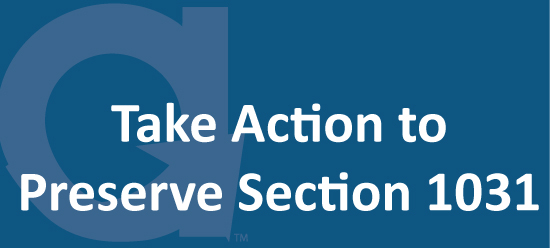The White House recently released details of President Joe Biden’s proposed $1.8 trillion American Families Plan. The Plan includes a cap on gains deferred through a 1031 exchange as a way to defray part of the Plan’s overall cost. The proposed limitation to 1031 exchanges would negatively impact American families and businesses.
This week, House Ways and Means Chairman Richard Neal notified the Committee’s members to be ready for the Committee reconciliation markup September 9-14. The Committee’s mark-up of their portion of the reconciliation bill will include all tax-related items in the legislation -this may include the proposed cap on Section 1031.
By clicking ‘take action today’ below you can quickly and easily send a letter to your representatives to let them know they should preserve Section 1031 rules and regulations in their current state.
Tag: 1031 exchange
-

Take Action To Protect Section 1031 Like-kind Exchanges – Tax Reform Update
-
Accruit Launches SaaS Offering of Exchange Manager Pro℠ Software
SaaS Offering of Exchange Manager ProSM
In 2020 and 2021, we have seen an unprecedented surge of interest in, and execution of, 1031 exchanges in all areas of the country. Qualified Intermediaries (QIs) all over America are challenged to keep up with demand for Exchange Manager ProSM reduces the time to create documents to just a few minutes, reducing the impact of such an interruption to an exchange specialist’s workflow while increasing client satisfaction.
System Notifications: Key communications such as deadline reminders, detailed next steps, and distribution of documents are all highly automated and configurable while opting in or opting out clients, advisors, referral sources, and other associated contacts as desired. Make sure all parties are aware of relevant milestones without having to maintain templates and set reminders.
Central Repository for all Exchange Documents and Other Data: Exchange Manager ProSM retains all exchange documents, system notifications, notes, and exchange data in one cloud-based location. Just a handful of clicks take you from exchanger details to exchange overview to exchange documents to fee information to sale or purchase details. -
Accruit Launches SaaS Offering of Exchange Manager Pro℠ Software
SaaS Offering of Exchange Manager ProSM
In 2020 and 2021, we have seen an unprecedented surge of interest in, and execution of, 1031 exchanges in all areas of the country. Qualified Intermediaries (QIs) all over America are challenged to keep up with demand for Exchange Manager ProSM reduces the time to create documents to just a few minutes, reducing the impact of such an interruption to an exchange specialist’s workflow while increasing client satisfaction.
System Notifications: Key communications such as deadline reminders, detailed next steps, and distribution of documents are all highly automated and configurable while opting in or opting out clients, advisors, referral sources, and other associated contacts as desired. Make sure all parties are aware of relevant milestones without having to maintain templates and set reminders.
Central Repository for all Exchange Documents and Other Data: Exchange Manager ProSM retains all exchange documents, system notifications, notes, and exchange data in one cloud-based location. Just a handful of clicks take you from exchanger details to exchange overview to exchange documents to fee information to sale or purchase details. -
Accruit Launches SaaS Offering of Exchange Manager Pro℠ Software
SaaS Offering of Exchange Manager ProSM
In 2020 and 2021, we have seen an unprecedented surge of interest in, and execution of, 1031 exchanges in all areas of the country. Qualified Intermediaries (QIs) all over America are challenged to keep up with demand for Exchange Manager ProSM reduces the time to create documents to just a few minutes, reducing the impact of such an interruption to an exchange specialist’s workflow while increasing client satisfaction.
System Notifications: Key communications such as deadline reminders, detailed next steps, and distribution of documents are all highly automated and configurable while opting in or opting out clients, advisors, referral sources, and other associated contacts as desired. Make sure all parties are aware of relevant milestones without having to maintain templates and set reminders.
Central Repository for all Exchange Documents and Other Data: Exchange Manager ProSM retains all exchange documents, system notifications, notes, and exchange data in one cloud-based location. Just a handful of clicks take you from exchanger details to exchange overview to exchange documents to fee information to sale or purchase details. -

1031 Exchange Timeline Overview and Considerations
https://www.accruit.com/sites/default/files/2022-01/1031-Exchange-Timel…;
IRC Section 1031 has been around for more than 100 years. Although the overall concept and purpose of reverse 1031 exchange, sometimes called a forward exchange. The main difference is that instead of the QI holding funds, they hold a property. After hiring the qualified intermediary, the taxpayer and QI will open an LLC that will act as the Exchange Accommodation Titleholder (EAT), which will hold the replacement property as the taxpayer sells the relinquished property. Once the EAT has taken the title of the new property, the exchanger has 45 days to identify the property they will be selling. After the initial 45 days, the taxpayer has the remaining 135 days of the total 180 to sell the property they identified and finalize the exchange.
Build-to-Suit or Improvement Exchange
There are times when a taxpayer would like to sell a property and exchange it for a property they would like to develop or improve. Build-to-suit exchanges refer to exchanges in which improvements are made on the property acquired. In a build-to-suit or improvement exchange, the taxpayer can sell their property to purchase and improve a new property or purchase the replacement property first and then use the funds from the sale of the relinquished property to pay back loans used to fund the initial purchase and improvements. In both cases, the taxpayer has 180 days to use the balance of funds to improve the property. Any funds that have not been used during the parking period are considered real estate “boot” and are subject to capital gain tax. The 180-day time limit begins when the EAT, set up with the QI before the exchange, assumes title of the property.
1031 Exchange Timeline Considerations
Following the timeline on a 1031 exchange is not always as easy as it sounds. A taxpayer may not be able to identify a suitable property to buy in the 45-day identification period. A taxpayer may not be able to sell their property within 180 days. Improvements on a property may take longer than 180 days. Once a safe harbor provision is not met, the exchange is no longer eligible for tax deferment.
Here are a few ways of setting yourself up for a successful exchange:If you want to begin a forward exchange, start looking for your replacement property as early as possible
You can stretch out this extra period by delaying the close date on your relinquished property, preventing your 45-day countdown from starting
If you have already identified a property you would like to purchase but have not been able to sell your current property, consider a reverse exchange. That way, you will ensure your purchase and have 180 days to sell the old property
To avoid unwanted delays that may cut your 1031 exchange timeline short, ensure that your financing is in order before entering into an exchange agreement -

1031 Exchange Timeline Overview and Considerations
https://www.accruit.com/sites/default/files/2022-01/1031-Exchange-Timel…;
IRC Section 1031 has been around for more than 100 years. Although the overall concept and purpose of reverse 1031 exchange, sometimes called a forward exchange. The main difference is that instead of the QI holding funds, they hold a property. After hiring the qualified intermediary, the taxpayer and QI will open an LLC that will act as the Exchange Accommodation Titleholder (EAT), which will hold the replacement property as the taxpayer sells the relinquished property. Once the EAT has taken the title of the new property, the exchanger has 45 days to identify the property they will be selling. After the initial 45 days, the taxpayer has the remaining 135 days of the total 180 to sell the property they identified and finalize the exchange.
Build-to-Suit or Improvement Exchange
There are times when a taxpayer would like to sell a property and exchange it for a property they would like to develop or improve. Build-to-suit exchanges refer to exchanges in which improvements are made on the property acquired. In a build-to-suit or improvement exchange, the taxpayer can sell their property to purchase and improve a new property or purchase the replacement property first and then use the funds from the sale of the relinquished property to pay back loans used to fund the initial purchase and improvements. In both cases, the taxpayer has 180 days to use the balance of funds to improve the property. Any funds that have not been used during the parking period are considered real estate “boot” and are subject to capital gain tax. The 180-day time limit begins when the EAT, set up with the QI before the exchange, assumes title of the property.
1031 Exchange Timeline Considerations
Following the timeline on a 1031 exchange is not always as easy as it sounds. A taxpayer may not be able to identify a suitable property to buy in the 45-day identification period. A taxpayer may not be able to sell their property within 180 days. Improvements on a property may take longer than 180 days. Once a safe harbor provision is not met, the exchange is no longer eligible for tax deferment.
Here are a few ways of setting yourself up for a successful exchange:If you want to begin a forward exchange, start looking for your replacement property as early as possible
You can stretch out this extra period by delaying the close date on your relinquished property, preventing your 45-day countdown from starting
If you have already identified a property you would like to purchase but have not been able to sell your current property, consider a reverse exchange. That way, you will ensure your purchase and have 180 days to sell the old property
To avoid unwanted delays that may cut your 1031 exchange timeline short, ensure that your financing is in order before entering into an exchange agreement -

1031 Exchange Timeline Overview and Considerations
https://www.accruit.com/sites/default/files/2022-01/1031-Exchange-Timel…;
IRC Section 1031 has been around for more than 100 years. Although the overall concept and purpose of reverse 1031 exchange, sometimes called a forward exchange. The main difference is that instead of the QI holding funds, they hold a property. After hiring the qualified intermediary, the taxpayer and QI will open an LLC that will act as the Exchange Accommodation Titleholder (EAT), which will hold the replacement property as the taxpayer sells the relinquished property. Once the EAT has taken the title of the new property, the exchanger has 45 days to identify the property they will be selling. After the initial 45 days, the taxpayer has the remaining 135 days of the total 180 to sell the property they identified and finalize the exchange.
Build-to-Suit or Improvement Exchange
There are times when a taxpayer would like to sell a property and exchange it for a property they would like to develop or improve. Build-to-suit exchanges refer to exchanges in which improvements are made on the property acquired. In a build-to-suit or improvement exchange, the taxpayer can sell their property to purchase and improve a new property or purchase the replacement property first and then use the funds from the sale of the relinquished property to pay back loans used to fund the initial purchase and improvements. In both cases, the taxpayer has 180 days to use the balance of funds to improve the property. Any funds that have not been used during the parking period are considered real estate “boot” and are subject to capital gain tax. The 180-day time limit begins when the EAT, set up with the QI before the exchange, assumes title of the property.
1031 Exchange Timeline Considerations
Following the timeline on a 1031 exchange is not always as easy as it sounds. A taxpayer may not be able to identify a suitable property to buy in the 45-day identification period. A taxpayer may not be able to sell their property within 180 days. Improvements on a property may take longer than 180 days. Once a safe harbor provision is not met, the exchange is no longer eligible for tax deferment.
Here are a few ways of setting yourself up for a successful exchange:If you want to begin a forward exchange, start looking for your replacement property as early as possible
You can stretch out this extra period by delaying the close date on your relinquished property, preventing your 45-day countdown from starting
If you have already identified a property you would like to purchase but have not been able to sell your current property, consider a reverse exchange. That way, you will ensure your purchase and have 180 days to sell the old property
To avoid unwanted delays that may cut your 1031 exchange timeline short, ensure that your financing is in order before entering into an exchange agreement -

1031 Exchange Timeline and Identification Requirements
Since 1921, the rules for qualifying and completing Accruit can help you put the pieces together for a successful 1031 exchange.
For the taxable gain to be deferred, specific vital requirements must be satisfied:Properties must be exchanged, rather than sold and then purchased
There must be no constructive or actual receipt of proceeds received by the taxpayer from the transfer of the relinquished property pursuant to the relinquished property contract
Properties must be “Like-Kind”
Properties must be held for business or investment purposes
Exchange must be equal or up in value
The exchange must follow time limit and identification requirements: A taxpayer must acquire or identify the target replacement property within 45 days after the transfer of the relinquished property. Properties received (purchased) within the 45-day designation period are deemed to be identified. The replacement property must be designated in a written document, unambiguously described, signed by the taxpayer, and received by the qualified intermediary on or before the 45th day. If the taxpayer identifies replacement property within the designated period, the exchange period end date may be extended up to 180 days from the transfer of the first relinquished property. This provides the taxpayer with additional time to complete the exchange. However, it might be necessary for the taxpayer to file a tax-filing extension to utilize the full 180 days.Property Identification
In a typical forward exchange, the taxpayer will hire a -

1031 Exchange Timeline and Identification Requirements
Since 1921, the rules for qualifying and completing Accruit can help you put the pieces together for a successful 1031 exchange.
For the taxable gain to be deferred, specific vital requirements must be satisfied:Properties must be exchanged, rather than sold and then purchased
There must be no constructive or actual receipt of proceeds received by the taxpayer from the transfer of the relinquished property pursuant to the relinquished property contract
Properties must be “Like-Kind”
Properties must be held for business or investment purposes
Exchange must be equal or up in value
The exchange must follow time limit and identification requirements: A taxpayer must acquire or identify the target replacement property within 45 days after the transfer of the relinquished property. Properties received (purchased) within the 45-day designation period are deemed to be identified. The replacement property must be designated in a written document, unambiguously described, signed by the taxpayer, and received by the qualified intermediary on or before the 45th day. If the taxpayer identifies replacement property within the designated period, the exchange period end date may be extended up to 180 days from the transfer of the first relinquished property. This provides the taxpayer with additional time to complete the exchange. However, it might be necessary for the taxpayer to file a tax-filing extension to utilize the full 180 days.Property Identification
In a typical forward exchange, the taxpayer will hire a -

1031 Exchange Timeline and Identification Requirements
Since 1921, the rules for qualifying and completing Accruit can help you put the pieces together for a successful 1031 exchange.
For the taxable gain to be deferred, specific vital requirements must be satisfied:Properties must be exchanged, rather than sold and then purchased
There must be no constructive or actual receipt of proceeds received by the taxpayer from the transfer of the relinquished property pursuant to the relinquished property contract
Properties must be “Like-Kind”
Properties must be held for business or investment purposes
Exchange must be equal or up in value
The exchange must follow time limit and identification requirements: A taxpayer must acquire or identify the target replacement property within 45 days after the transfer of the relinquished property. Properties received (purchased) within the 45-day designation period are deemed to be identified. The replacement property must be designated in a written document, unambiguously described, signed by the taxpayer, and received by the qualified intermediary on or before the 45th day. If the taxpayer identifies replacement property within the designated period, the exchange period end date may be extended up to 180 days from the transfer of the first relinquished property. This provides the taxpayer with additional time to complete the exchange. However, it might be necessary for the taxpayer to file a tax-filing extension to utilize the full 180 days.Property Identification
In a typical forward exchange, the taxpayer will hire a